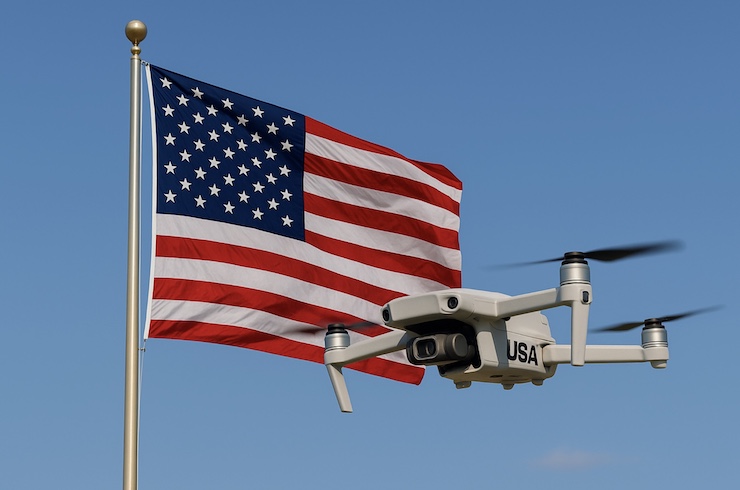Trump Signs Executive Order to Bolster Domestic Drone Industry

During his first term, President Donald Trump increasingly framed drones as both a national security priority and a strategic economic asset. As early as May 2018, his administration raised alarms about the widespread use of Chinese-manufactured drones, particularly those from DJI, which dominated the U.S. market. Citing risks of espionage and data vulnerability, the Department of Homeland Security issued an alert warning that Chinese drones could be transmitting sensitive flight data back to Beijing. By January 2020, the Department of the Interior grounded nearly 800 drones sourced from China. Trump’s broader strategy was to push for the development of an American-made drone industry, aiming to reduce reliance on foreign technology and protect critical infrastructure.
This policy direction aligned with Trump’s broader vision of technological dominance. At a June 2017 meeting with tech executives, he stated, “We want to remain number one. We’re on the verge of new technological revolutions that could improve virtually every aspect of our lives, creating vast new wealth for American companies and families.” His administration’s efforts, including loosening regulations on commercial drone flights and allocating funding for domestic innovation, were designed not only to stimulate private-sector growth but also to ensure that America led the global race in autonomous aerial systems, from drone delivery to smart infrastructure inspection.
During President Joe Biden’s time in office, he agreed with Trump’s concerns over the possibility that Chinese drones could lead to security breaches. However, he did not believe that imposing strict bans on the sale of these drones was the right approach. The reality was that the United States remained heavily reliant on drones manufactured in China. Many of the most popular consumer drones in the U.S., including models like the DJI Mavic Air 2, cost as little as $135 to manufacture and retail for around $800 to $1,000, making it difficult for domestic companies to compete. Comparable American-made drones, such as those from Skydio, often sell at significantly higher prices due to increased labor, material, and assembly costs in the U.S.
President Biden actively encouraged the domestic drone industry by imposing higher tariffs on Chinese drone products, enacting the FY 2025 National Defense Authorization Act, which barred federal agencies from purchasing Chinese drones or components, offering incentives to U.S. manufacturers, and advancing the Pentagon’s Replicator Program to rapidly produce American-made drone systems for national defense at reduced costs. Now, 138 days into his second term, President Trump has signed new executive orders aimed at further strengthening the United States’ drone industry.
On Friday, June 6, 2025, President Trump signed three executive orders focused on expanding commercial drone operations, improving airspace security against foreign threats, and advancing cutting-edge technologies like flying taxis and supersonic jets. These orders, Unleashing American Drone Dominance, Restoring American Airspace Sovereignty, and Leading the World in Supersonic Flight, are intended to ensure the U.S. leads the future of aviation. Central to the Unleashing American Drone Dominance order is a directive for the Federal Aviation Administration (FAA) to accelerate the integration of drones into national airspace.
A key element of the order requires the FAA to enable routine Beyond Visual Line of Sight (BVLOS) operations, widely considered essential for drones to reach their full commercial potential. Currently, with rare experimental exemptions, drone operators must keep aircraft within Visual Line of Sight (VLOS) at all times. Enabling BVLOS would eliminate these distance restrictions, unlocking new applications in package delivery, infrastructure inspection, agriculture, and emergency response, sectors poised for rapid technological transformation.
Additionally, the order tasks the FAA with developing artificial intelligence tools to streamline the waiver review process for drone systems, allowing them to be integrated into the airspace more efficiently. At the same time, this integration must account for security around sensitive areas such as federal buildings and airports. Notably, the order does not ban the use of internationally made drones, such as those from DJI or Autel, by private individuals or federal agencies.
Rather, the order builds on the groundwork laid during the Biden administration by encouraging the continued strengthening of the American drone supply chain. “Red tape has hindered homegrown drone innovation, restricting commercial drone use and burdening their development,” said Michael Kratsios, director of the White House Office of Science and Technology. By streamlining regulations and prioritizing American-made technology, the new order aims to remove those barriers and accelerate growth across the industry. It marks a continued shift toward securing America’s autonomy in the skies, economically and strategically.
|